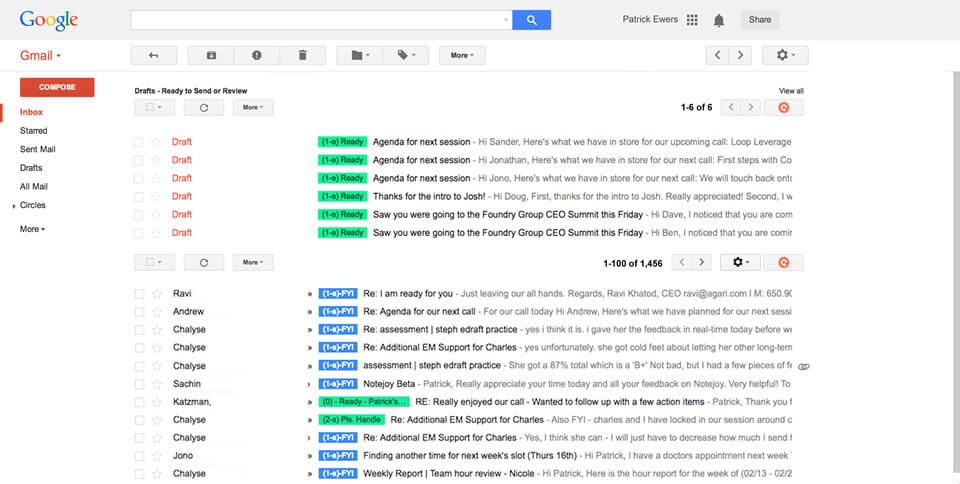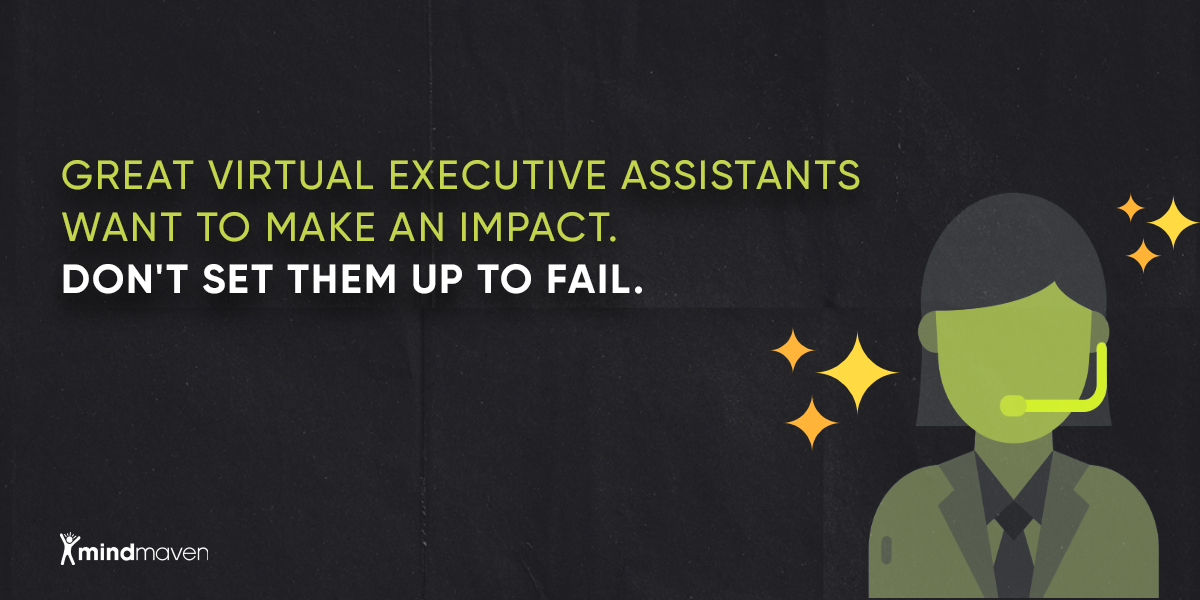The Journey So Far
The decision to work with a virtual Executive Assistant is a pivotal moment, but the journey there often isn’t easy and usually looks something like this:
It starts with a core team led by a scrappy DIY-type CEO determined to become an exceptional leader and build something great.
But as the company becomes more successful, the pressures and responsibilities on the CEO mount, causing them to feel increasingly less productive despite working longer hours.
As their backlog grows and important responsibilities fall through the cracks, they begin to feel like they’re failing their team and undermining everything they’ve worked so hard to achieve.
This overwhelming reality often forces the leader to confront the fact that the velocity of their team is limited by their velocity as CEO.
They realize something has to change and look for ways to increase their throughput.
One of the most immediate solutions? Hiring a virtual Executive Assistant.
In this article, we’ll explore five steps to transform your virtual Executive Assistant into a rockstar, giving you the Leverage to reach your fullest potential as a Superpowered leader.
With Mindmaven’s executive coaching engagement, we’ll help you free up 12+ hours every week by changing the way you work with your Executive Assistant.
Table of Contents
ToggleWhat is a virtual Executive Assistant?
A virtual Executive Assistant is a remote professional who provides high-level administrative and strategic support to busy executives.
When fully leveraged, they go beyond a task-taker and evolve into a proactive partner capable of anticipating your next move.
Virtual Executive Assistants enable you to reach your fullest potential as a leader and consistently contribute to the success of your company at the highest level.
Working with a virtual Executive Assistant can directly impact the velocity of your company, maximize your productivity, and free up 12+ hours every week to invest in key relationships that drive your success.
But only if that relationship is built right.
Two Approaches That Could Be Hindering Your Virtual Executive Assistant
While a virtual Executive Assistant has the potential to transform the way you lead and succeed, many executives fall into two common traps that restrict this relationship:
1. The (Limited) Traditionalist: Someone who hires a virtual Executive Assistant with the goal of simply “saving time” by offloading basic administrative responsibilities (such as calendar management or travel booking).
The problem with this approach is it aims too low, leaving substantial value on the table and only creating incremental improvements. This can often lead to people feeling let down as they wonder if the hire was worth it in the first place.
2. The (Impractical) Dreamer: Someone who dreams of an assistant who’s always “one step ahead of them” (and anticipates the massive leverage this will create).
The problem with this approach is it often assumes “hiring an experienced virtual Executive Assistant” is all it takes to get those results. When reality doesn’t immediately match their expectations, this approach often leads to execs settling for “good enough.”
Both approaches often lead to disappointment, but it doesn’t have to be that way.
Let’s take a look at how you can transform your relationship with your virtual Executive Assistant …
5 Steps To Working With a Rockstar Virtual Executive Assistant
Whether you’ve been working with your virtual Executive Assistant for three months or three years—or even if you’re just thinking about taking the plunge—here are 5 changes that will help you take things to the next level.
#1: Climb Out of the Tradition Trap
Most virtual Executive Assistants have the potential to free up massive amounts of time, maximize productivity, and—most importantly—enable you to reach your fullest potential as a leader.
Yet too many execs never reach that level because they fall into what we call the “Tradition Trap.”
As described above, many leaders subscribe to an outdated, uninspired, “traditional” vision for the Executive Assistant role. Ultimately, they settle for a glorified office admin: someone who manages travel, books meetings, and takes care of general administrative tasks.
As a result, they might describe their assistant as “helpful” but not “game-changing.” They’re missing out.
If you’ve invested in a virtual Executive Assistant, you’re probably sitting on a treasure trove of untapped potential. Why settle for anything less than game-changing?
At Mindmaven, we believe “game-changing” should be the standard; but for that to happen, a new approach and mindset is required from both virtual Executive Assistants and executives.
To that end, we created a new role we call an “Engagement Manager” (or EM).
Transform Your EA Into an Engagement Manager
Transforming your virtual Executive Assistant into an Engagement Manager means reimagining the role entirely.
An Engagement Manager is a powerful hybrid of a skilled virtual EA and a strategic Chief of Staff, whose primary responsibility is empowering you to reach your fullest potential as a leader.
If you’ve hired an assistant just to “save time” or “increase productivity,” you’re aiming too low. When you shift toward the Engagement Manager model, you do far more than save 2-3 hours a day.
Transforming your virtual Executive Assistant into an Engagement Manager allows you to unlock the Leverage you need to become the kind of leader your team—and your company—deserve.
Although increased productivity is a natural part of that process, it shouldn’t be the end goal.
What Does an Engagement Manager Do?
Nearly every aspect of your role—from how you manage your inbox to the way you lead your team—has the opportunity to be transformed by an Engagement Manager.
Here are a few examples:
Clearing the Bottleneck
An Engagement Manager can improve your velocity and throughput by tracking your commitments, structuring your day around your most important priorities, and ensuring you follow through on near-100% of your responsibilities faster than ever.
For example, imagine …
- Maximizing meeting productivity (and saving 60+ minutes/day) when your EM drafts ready-to-send follow-up emails, so all you have to do is review and press “send.”
- Being able to follow through on 100% of your commitments by implementing our Loop Leverage playbook where your EM tracks your action items and either:
a) Holds you accountable to ensure they don’t fall through the cracks or
b) Proactively completes them for you (like drafting an email sharing that book you recommended to your VP of Product in yesterday’s meeting).
- Having four consecutive hours every Wednesday dedicated to developing next year’s marketing plan (or anything else it feels like you “don’t have time for” today) because your EM proactively blocks off and protects that time each week.
Owning the Inbox
With the right skills, permissions, and calibration, an Engagement Manager can reduce the time you spend on email by 40-60%.
How? By prioritizing your inbox into three categories before you even see it:
- Prewritten ready-to-send drafts for the (surprising number of) emails your virtual Executive Assistant/Engagement Manager is capable of handling,
- “Pls Handle” for emails that need input or action from you, and
- “FYI” for update emails that require no action or urgency from you.

That alone can save hours each week, but it’s just the beginning: An Engagement Manager can also empower you to deliver more meaningful email experiences by proactively identifying future interactions.
For example: Imagine your virtual Executive Assistant/Engagement Manager sees an email in your inbox mentioning a former colleague’s upcoming cross-country move.
Three months later—without prompting from you—an email (written by your Engagement Manager) shows up in your Drafts folder asking about the move and even recommending a few places they could take their family to celebrate settling in.
The best part? All you need to do to deliver this experience is click “Send.”
#2: Let Go of the Guilt Trip (and Stop “Splitting the Difference” with Your Team)
Often, executives put off hiring a virtual Executive Assistant for too long with thoughts like, “It’s not fair that I get an assistant while the rest of the team struggles.”
Even post-hire, guilt can continue to sabotage the partnership with suboptimal decisions like sharing a single virtual Executive Assistant among multiple executives.
Or they may choose to split their assistant’s focus between various roles (such as virtual Executive Assistant and office administrator).
While the intentions are good, the results are often underwhelming because the Leverage a virtual Executive Assistant can offer decreases exponentially for each additional executive they support.
Ultimately, letting guilt guide decisions often leads to two things:
- Demoralized virtual Executive Assistants who feel like they’re barely keeping their head above water and falling short of their own expectations (negatively impacting their motivation and potentially threatening their longevity in the role), and
- Flustered executives who hoped for a significant boost in productivity but often feel their expectations aren’t being met (causing them to use their virtual Executive Assistant increasingly less).
The more divided a virtual Executive Assistant’s attention is, the less meaningful their impact on the things that matter most (such as helping you reach your fullest potential).
We’ve yet to see someone achieve full leverage with a shared assistant. In our experience, the best results come from a single Engagement Manager supporting a single executive.
Great virtual Executive Assistants want to make an impact. Don’t set them up to fail.
Working 1:1 with a dedicated assistant isn’t about taking more than you deserve. It’s about empowering you to give your team the time, energy, and focus they deserve.

#3: Extinguish Trial-by-Fire (and Fast-Track Leverage)
The costs associated with hiring a virtual Executive Assistant aren’t just limited to the salary or initial onboarding period.
It’s important to also factor in the time and energy necessary to reach game-changing levels—and too often, executives underestimate how intensive that process can be.
Even an experienced virtual Executive Assistant has to climb a steep learning curve before they can become a fully leveraged Engagement Manager.
Engagement managers’ game-changing capabilities are the result of highly personalized coaching. Yet, too often, we see executives operate out of the sub-optimal mindset that because their virtual Executive Assistant’s primary responsibility is supporting their needs, they’re the only person who can properly onboard them.
If that sounds like you, I’d challenge you to answer two questions honestly:
Are you really the best person to coach your virtual Executive Assistant?
When executives coach virtual Executive Assistants alone, they’re in danger of:
a) Falling into the “Tradition Trap” and leaving value on the table, and
b) Training in the same inefficiencies they’re looking to eliminate.
While executives shouldn’t be totally removed from the onboarding process, their time is better spent on high-level calibration (like teaching their virtual Executive Assistant to draft emails in their voice or help plan meaningful date nights with their partner), not basic fundamentals (like learning to color-code a calendar or track action items).
Do you really have the time to invest in coaching a virtual Executive Assistant?
As mentioned above, it’s easy to underestimate exactly how much time and energy it takes to onboard an assistant. Too often, we see executives become overwhelmed as they attempt to balance this alongside their other responsibilities.
This usually ends with a frustrated executive settling for “good enough” because they don’t have the time needed to reach breakthrough levels with their virtual Executive Assistant.
The problem with “good enough” is that it runs counter to the reason many executives hire a virtual Executive Assistant in the first place: contributing to the success of their team at the highest level.
One of the most effective ways to overcome those challenges is to work with Mindmaven’s expert executive coaches. Our coaches offer unlimited hours of training for your virtual Executive Assistant, specializing in the high-leverage skills needed to fully support and empower you as a leader.
Remember: Working with an Engagement Manager isn’t just about freeing up time; it’s about reaching your fullest potential as a leader, and that’s a path most effectively traveled with a coach who’s seen and done it before!
#4: Recognize the Biggest Limiting Factor (is You)
If you resonated with the “Limited Dreamer” approach above, this one’s especially important:
One of the easiest mistakes an executive can make is assuming they already “know it all” because they’ve worked with a virtual Executive Assistant before or will “figure it out.”
The truth is the executive often needs even more coaching than the assistant.
Working with an Engagement Manager requires fundamental shifts in an executive’s operating style, and those changes often don’t come naturally.
You could hire the most qualified, high-caliber virtual Executive Assistant possible … But if you don’t know how best to work with them, you’ll miss out on massive value.
For example, do you know how to empower your Engagement Manager by …
- Dictating meaningful, valuable follow-up emails so they can write a draft that feels like it’s coming from you (even if all you do is click “send”)?
- Delivering a single 5-minute interaction to a team member that they can leverage to combat CEO loneliness, improve company culture, and increase team loyalty?
- Providing fast-paced, organic feedback to streamline the learning process and reduce the need for multiple hour-long 1:1s?
- Setting up your inbox in a way that equips them to communicate which emails are ready to send, which require your involvement, and which just need a quick review?
- Capturing and sharing key takeaways from meetings to help them ensure nothing falls through the cracks while also delivering meaningful experiences to your network?
All that’s just scratching the surface. If you’re serious about maximizing your partnership with your virtual Executive Assistant, working with a coach is one of the best ways to reach that level as quickly (and painlessly) as possible.
#5: Give Your Virtual Executive Assistant a Day-One Promotion
Executives with a limited vision for the role of a virtual Executive Assistant undercut the success of that relationship from day one.
The executives we’ve seen achieve the most success with their assistants view them as partners rather than just “assistants.”
For these executives, this hire meant founding a new two-person team (the executive and the Engagement Manager) with a single goal: Empowering the executive to contribute to the success of their team at the highest level.
This mindset shift is critical for the success of the relationship and leads to three core benefits:
1. The “Extra Mile” as the New Standard
An Engagement Manager who feels like a valued partner—not just a service provider—looks for opportunities to go above and beyond.
For example: Your Engagement Manager might hear about a recent intern-turned-engineer who pulled an all-nighter to restore server stability and do three things:
- Bring the event to your attention (since it may accidentally go unnoticed otherwise).
- Draft a ready-to-send email on your behalf, sharing how much you appreciate their willingness to go above and beyond for the company, and
- Suggest gifting the engineer with a company-funded night at their favorite restaurant (something your Engagement Manager knows because they’re so connected to the team) as thanks.
A service provider might be so disconnected from the team they don’t even hear about the event—or, if they do, think something like that goes beyond their responsibilities.
A partner, on the other hand, is constantly looking for opportunities to go the extra mile.
2. Support Through (Inevitable) Hard Times
As an executive, it’s easy to feel a sense of isolation that can negatively impact your ability to lead your company.
An Engagement Manager partnership can relieve some of that pressure by having someone in your corner who can lighten some of the burdens that come with leadership.
After all: If your Engagement Manager has full access to your inbox and calendar, they know your business and its challenges like no one else. That insight allows them to empathize with you on a level few others can.
For example, imagine having to break the news to the team that a major VP of Marketing candidate fell through last minute.
With an Engagement Manager, you could safely vent your frustrations and—most importantly—brainstorm actionable next steps and plan how to share the news.
3. Limitless Scalability
It’s not uncommon to see an executive hire an Engagement Manager, get “addicted” to the benefits, and then hire another to create even more powerful results.
For example, after a year or two, your virtual Executive Assistant may become such an integral part of the company that they’re more chief of staff. At this point, it may not make sense for them to continue managing your calendar or shadowing your inbox.
Instead, you may assign them higher-impact directives (such as helping with the recruiting process for a Head of Growth or organizing and prioritizing executive KPIs), then have them hire a junior Engagement Manager for calendar management, email drafting, and meeting debrief processing.
The core message is this:
Think of your Engagement Manager as an invaluable partner in one of your company’s most important teams. They are someone who plays an integral role in enabling you to be the leader your organization needs to reach its fullest potential.
Anything less, and you may be selling yourself, your Engagement Manager, and your team short.
The Bottom Line: Transforming Your Virtual Executive Assistant Into an Engagement Manager
Transforming a virtual Executive Assistant into a rockstar partner is about doing less and achieving more.
By avoiding common traps and adopting the Engagement Manager model, executives can unlock powerful leverage, increase their velocity, and gain back 12+ hours every week.
With the right mindset, coaching, and support structure — like what Mindmaven’s executive coaching offers — your assistant can undoubtedly become one of the most valuable assets in your organization.
Next Steps: Maximize Your Partnership With a Virtual Executive Assistant
We hope this article has helped change the way you view the role of a virtual Executive Assistant and challenge you to take your partnership to the next level.
But even if this resonated, you might have some concerns. For example:
- “That all sounds great, but I don’t know where to start.”
- “That might work for some people, but there’s no way I’d be comfortable delegating my inbox/relationship/commitments/etc. to my assistant.”
- “I like the concepts, but don’t think I have the right support in place to roll these strategies out.”
We’ve heard it all before, and whatever your concerns, we probably have an intriguing answer or perspective.
If you’re excited about the role of a virtual Executive Assistant—regardless of any implementation concerns you may have—we believe you owe it to yourself, your team, and the future of your company to have a chat with us.
If there’s one thing we’ve learned over the years, it’s this …
Although every virtual Executive Assistant/executive partnership is unique, nearly all can be taken to the next level—and we’d love the opportunity to explore what that looks like for you.
Learn how we can help you find, hire, and maximize your partnership with a virtual Executive Assistant by setting up a free consultation—simply request a call here.






